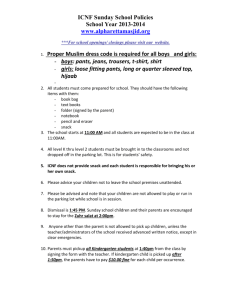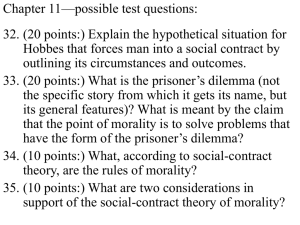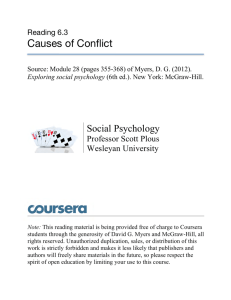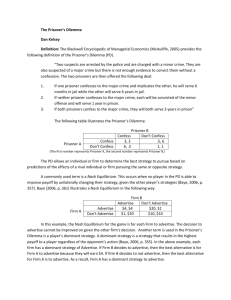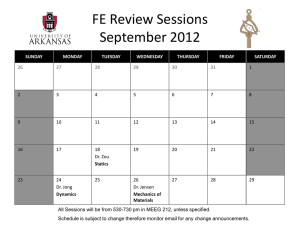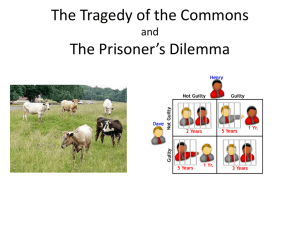AL2_Pembertons_Dilem..
advertisement
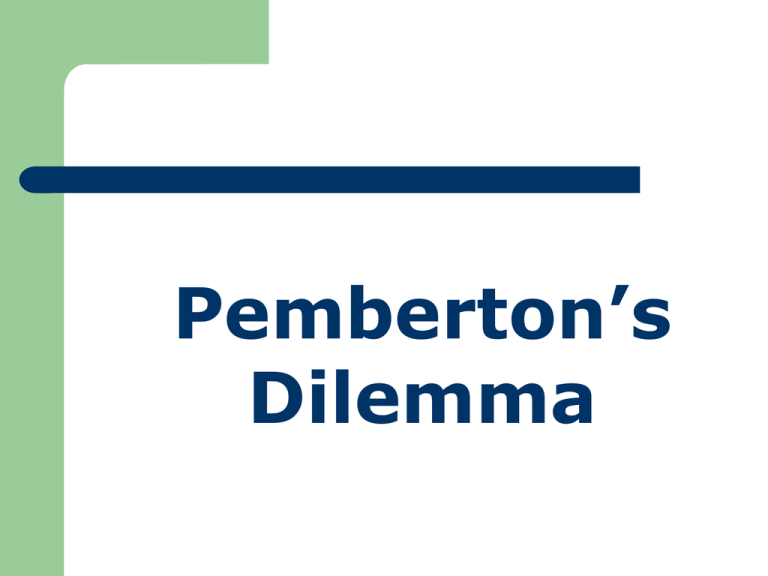
Pemberton’s Dilemma Introduction: This exercise creates a situation in which you and the others will be making separate decisions about how to manage your firm. The outcomes (profits and losses) are determined not only by what you do, but also by a number of other factors such as the goals and motives that you and the other party have and the communication that takes place between you and them. Procedure: • Divide your groups into two management teams (Country Market & Corner Store) • Prepare sheets of paper for each management team: one ½ crosswise (tally sheet) and two ¼ sheets (decision cards) • Represent your store in discussions with the other store about the decision to operate (or not) during Sundays Procedure: • There will be 12 one-minute rounds where stores will simultaneously decide whether they will open or not • You execute your decision by revealing to the other team the appropriate card (“open” or “closed”) at the same time that the other team is revealing their card to you. Procedure: • Each round represents one Sunday; every 4th Sunday is part of a long weekend • A two-minute confidential planning session separates each Sunday • The two teams may, if they so desire, negotiate with each other for 3 minutes IMMEDIATELY FOLLOWING WEEKS 4 AND 8 ONLY. Relevant Information: • Commercial activity in Pemberton has been prohibited during Sundays • Sunday shopping has been permitted in the metropolitan center just 30 minutes away • Both Country Market and Corner Store have been consistently losing potential profit as Sunday shopping becomes more popular Relevant Information: • If both stores remain closed on a Sunday, each will have the usual $20,000 weekly profit • If only one store opens on a Sunday, it will earn a $40,000 profit for that week while the other store will incur a $40,000 loss • If both stores decide to open on a Sunday, each will incur a $20,000 loss for that week Building Your Team Strategy • After reading the instructions/relevant information, answer 2 questions with your team: 1.What are your objectives for this game? (what for) 2.What are the moves that you will make to meet these objectives? (how) Pay-off Chart: Close Open Corner Store Country Market Close Open CS: +$20,000 CS: -$40,000 CM: +$20,000 CM: +$40,000 CS: +$40,000 CS: -$20,000 CM: -$40,000 CM: -$20,000 Sample Tally Sheet: Round (Sunday) Decision CS CM Profit/Loss CS CM 1 2 3 Open Close Open Close Open Open +$40,000 -$40,000 -$40,000 +$40,000 -$20,000 -$20,000 4 Close Close +$20,000 +$20,000 Debrief: Review the outcomes from summary table- what do we see? a/Both high and positive scores-usually a strong cooperative pair b/Both moderate scores-often a group that learned to cooperate c/ Both low scores-usually a competitive pair d/ Groups with large difference between scores-one group took advantage of the other Dilemma Characteristics: • Individual choices reflected in joint outcomes • Interdependence affects outcomes: Payoff to self is the only reward (lack of concern for the other) • Mutual Adjustment: Influence on negotiating partner- change over time • Value Claiming and Value Creating: which is the more prominent goal • Lack of Direct communication, ability to make binding agreements, trust Can the Dilemma be avoided? • Lengthen the shadow of the future (repeated rounds) • Use Sophisticated Strategies • Use knowledge of the other- probability of the other’s move • OR Can the Dilemma be avoided? • Interdependent: When the parties depend on each other to achieve their own preferred outcome they are interdependent; they are characterized by interlocking goals. • Recognize that negotiation is a process that transforms over time, and mutual adjustment is one of the key causes of the changes that occur during a negotiation- Revenge • Realize successful coordination of interdependence has the potential to lead to synergy, which is the notion that “the whole is greater than the sum of its parts.” In effect we can increase the size of the pie. • Manage conflict whether it is inter-group, intra-group, interpersonal, or intrapersonal Overview • Viewed as a fixed pie situation: we lose-they gain • Non verbal communication: • Choices based on previous moves • Gestures • Emotion around losses – betrayal, revenge • Loss of focus on strategy and goals • Intra-group challenges • Agreeing on goal strategies • Backing representatives Negotiators Dilemma: Competitive Cooperative Negotiator A Negotiator B Cooperative Competitive Both + A B ++ A ++ B -- Both - Negotiator’s Dilemma • How to cooperate and create value at the table without being taken advantage of or becoming hostage to the relationship • How to compete or claim value at the table without damaging the relationship or blocking the negotiation • How to maximize value while minimizing risk The End The End Prisoner Dilemma Two men suspected of committing a crime are arrested by the police and placed in separate cells. Each is told that he may either confess to the crime or remain silent. Each is told that if he confesses and his partner does not, the one who confesses turns state's evidence against the other and goes free while the other will go the jail for a long time (e.g., 10 years); if both confess, they both go to jail for a moderate term (e.g. 5 years); but, if neither confesses, then the police will have them found guilty of a lesser charge - carrying concealed weapons - - and sent to jail for 1 PrisonerDilemma: Confess Silent Prisoner 1 Prisoner 2 Silent Confess P1-1 Year P1 - 10 years P2- 1 Year P2- Free P1- Free P2 – 10 Years P2: - 5 Years P1: - 5 Years
